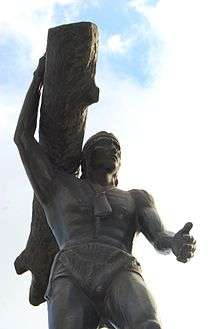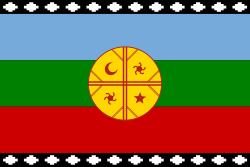Caupolicán

Caupolicán (? in Pilmaiquén – 1558 in Cañete) was a Toqui, the military leader of the Mapuche people of Chile, who commanded their army during the first Mapuche rising against the Spanish conquistadors from 1553 to 1558. He was the leader (cacique) of Palmaiquén, and, following the death of Lautaro in 1557, he was made chief.[1]
Following the successful campaign of conquest by Pedro de Valdivia in Araucanía and the failure of the toqui Lincoyan to stop them, the Mapuche were persuaded by Colocolo to choose a new supreme war leader in response to the Spanish threat.
Caupolicán as an Ulmen of Pilmayquen won the position of Toqui by demonstrating his superior strength by holding up a tree trunk for three days and three nights.[2] In addition to proving his physical power, he also had to improvise a poetic speech to inspire the people to valor and unity.
His attacks were against the newly arrived Spanish governor of the area, García Hurtado de Mendoza (1535-1609), but they were fended off by the Spaniards. The Spanish defeated the Araucanians in the battles of Langunillas and Millarapue in 1557. In 1558 the Spanish surprised Caupolicán's encampment and captured him. They executed him by impalement.[3] making him sit on a stake while his wife was forced to watch. After his death he was replaced by his son Caupolicán the younger.
He is remembered as a hero of the Araucanian resistance to the Spanish conquest. At least two statues of him have been created, one in Santa Lucía, Chile[4] and another by José Toribio (pictured).ad
See also
References
- ↑ Simon Collier, "Caupolicán" in Encyclopedia of Latin American History and Culture, New York: Charles Scribner's Sons 1996, vol. 2, p. 40.
- ↑ Caupolicán carried it for two days and one night according to Vivar, Cap. CXVII. Alonso de Ercilla made it three days and three nights.
- ↑ Collier, "Caupolicán" p. 40
- ↑ Collier, "Caupolicán" p. 40 has a photo
Sources
- The first history of Chile was written in 1558 by Jerónimo de Vivar, Crónica y relación copiosa y verdadera de los reinos de Chile (Chronicle and abundant and true relation of the kingdoms of Chile) ARTEHISTORIA REVISTA DIGITAL; Crónicas de América (on line in Spanish)
- Much of the legend of Caupolicán is found in the epic poem La Araucana by Alonso de Ercilla, a major piece of literature about the Spanish conquest of the Americas.
